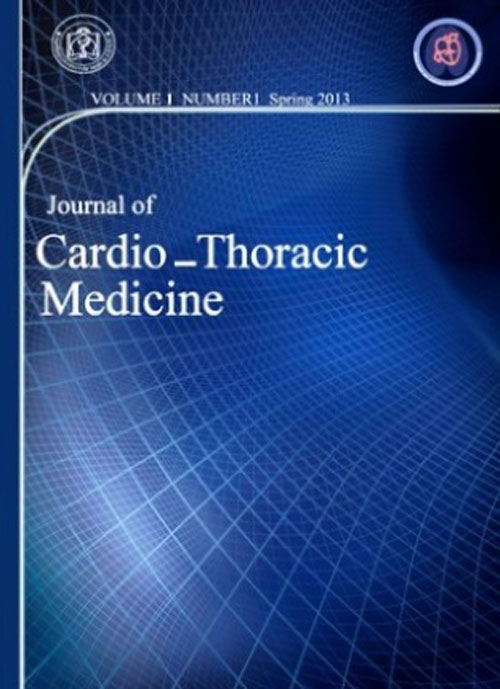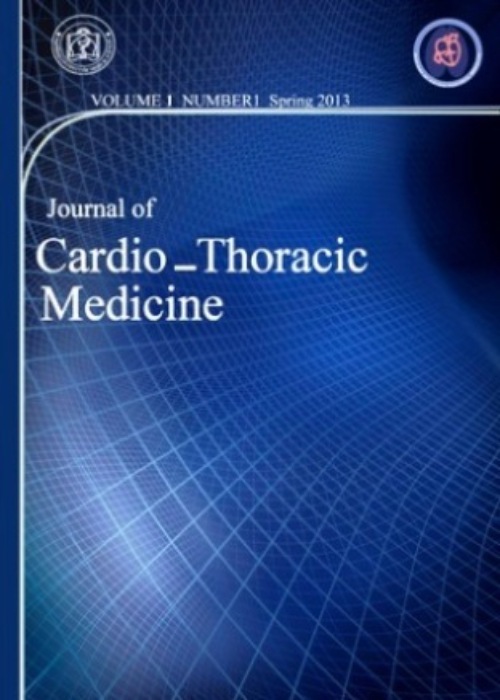فهرست مطالب

Journal of Cardio -Thoracic Medicine
Volume:10 Issue: 1, Winter 2022
- تاریخ انتشار: 1401/01/15
- تعداد عناوین: 7
-
-
Pages 913-918IntroductionPrevious studies have suggested that diabetes mellitus and obesity are associated with an increased risk of severe complications with COVID. We aimed to investigate whether individuals with obesity and diabetes mellitus are more likely to be infected with COVID19.MethodsThe information related to COVID-19 was extracted from the Sina Health system information of Mashhad Health Deputy among participants in Mashhad cohort study (n=9704 people). Information regarding the cardiac risk factors of the individuals was previously recorded during the recruitment phase of the Mashhad cohort study. The relationship between COVID infection and several CVD risk factors was investigated.ResultsThe results showed that obesity (P= 0.001) and diabetes mellitus (DM), (P= 0.01) were positively related to COVID-19. Furthermore, DM augmented the risk of COVID-19 by 1.79 folds (P-value= 0.004; OR: 1.79; CI:1.21-2.67).ConclusionsThe incidence of COVID-19 until 2020.07.19 was 2.36% in Mashhad Study Cohort population. Moreover, DM has increased the risk of COVID-19 by 1.79 folds in the population.Keywords: COVID-19, Cardiovascular Disease, Risk Factor
-
Pages 919-924IntroductionOseltamivir is an antiviral drug used to treat H1N1 influenza. FDA added a warning to the label of oseltamivir drawing attention to the risk of developing neuropsychiatric adverse events. There are some case reports reported psychiatric symptoms on oseltamivir intake. However, data is scarce on the emergence of psychiatric symptoms following oseltamivir administration.Materials and MethodsSixty patients, who received oseltamivir for prophylaxis or treatment for H1N1 swine influenza in the preceding six months, were enrolled in this study. The mini neuropsychiatric screener for DSM4 and a semi-structured proforma was applied that included socio-demographic information of patients, past psychiatric history, medical comorbidities, use of concomitant medication, dose and duration of use of oseltamivir. T-test and chi-square test were used to compare parametric data and categorical data respectively. P-value ≤ 0.05 was used for statistical significance.ResultsOf 60 patients, 22(36.67%) patients had developed psychiatric symptoms after receiving oseltamivir. 11(50%) patients had sleep issues, and there were 6(27%) patients with delirium, 3(9%) with depression and 3(9%) with anxiety and 1(5%) with psychosis. Among 22 patients, 4 subjects had past history of psychiatric illness (p-value = 1.00) and 15 had past medical illness (p-value = 0.003). Patients who developed psychiatric manifestations were significantly older (p-value: 0.05) and had lower years of education (p-value: 0.01).Conclusions36.67% of patients developed psychiatric side effects following oseltamivir use. Predominant symptoms included sleep issues and delirium. Those who developed psychiatric symptoms had a significant background history of medical illness. Therefore, it is recommended that those who receive oseltamivir regularly be screened for psychiatric symptoms.Keywords: Oseltamivir, Influenza A virus, H1N1 subtype, Disease Outbreaks, Psychotic disorders
-
Pages 925-930Introduction
Air leak is one of the post-surgical complications following thoracic surgeries. Studies have shown that patients with more intraoperative air leaks are at higher risk of developing prolonged postoperative air leak. Various adjuncts have been used in attempts to reduce alveolar air leaks (AAL). One of these, is the topical application of Glubran-2. This study examines the role of Glubran-2 in management of air leak in patients with chronic empyema.
MethodsThis was a randomized clinical trial that included 44 patients with chronic pulmonary empyema who underwent decortication and pleurectomy. They were divided into 2 equal groups. In the first group, Glubran-2 was used for management of air leak and in another group other routine methods were used for this purpose. Patients in each group were assessed according to their age, sex, location of the lesion, cause of the lesion, air leak and duration of hospitalization. The data were analyzed using the software Statistical Package for the Social Sciences (SPSS Inc, Chicago, IL) software.
ResultsAll data of the clinical features showed no significant difference among case and control group in patients with chronic empyema at baseline (P>0.05). Alveolar air leak duration and duration of hospitalization were significantly lower in the sealant group compared to the no-sealant group (P< 0.001 and P< 0.01, respectively). Prolonged AAL (PALL) was found in 5 (50.0 %) patients in the case group and 15 (83.3 %) patients in the control group for a total of 20 (50 %) patients. There was no significant difference between the two groups regarding PAAL (P= 0.77).
ConclusionOur results support the use of Glubran-2 glue for decreasing alveolar air leak and then decreasing duration of hospitalization in the patients who underwent the thoracic surgeries.
Keywords: air leak, Complications, glubran glue, Surgery -
Pages 931-936Introduction
Chronic kidney disease is an ailing condition that in the final stages can lead the patient to renal replacement therapies such as dialysis. An arteriovenous fistula (AVF) with proper function and maturation is needed with this regard. The aim of this study was to evaluate the effect of blood pressure on the function and maturation of AVF and AVG.
Materials and MethodsThis retrospective cross-sectional study was performed between September 2016 and March 2019 on all patients with chronic renal failure, who referred to the Alavi Vascular Surgery Hospital as candidates for hemodialysis and underwent AVF implementation by the researchers. Using a predesigned checklist, the hospital records of all patients were reviewed and data including the demographic information of patients (age and sex), previous medical history (diabetes, hypertension), smoking status and blood pressure of the patient before and after surgery were extracted. In order to follow the patients and evaluate the function and maturation of the fistula, the dialysis centers in Mashhad were contacted and information about the successful dialysis of the patients was recorded. Data were extracted from the forms and entered into SPSS software and at the end, patients' blood pressure was compared between functional and unfunctional groups and also in terms of access type.
ResultsTotally, 298 cases were enrolled in the study and classified into two groups including 242 (81.2%) functional AVFs and 56 (18.8%) unfunctional AVFs. The mean age of the patients was 55.15±17.93 years and the median was 58.5 (67.0-43.0) years old. Moreover, 152 patients (51.0%) were male and 146 patients (49.0%) were female. There was no significant difference regarding age (p=0.057) and gender (p=0.290) between the two study groups. Furthermore, underlying diseases (diabetes and hypertension) showed significant difference between the two study groups (p<0.001). Only, diabetes relative frequency showed significant difference between fistula and graft groups (p=0.022). The median systolic (SBP) and diastolic blood pressure (DBP) was significantly higher in functional group compared to the unfunctional (p<0.05). However. There was no significant difference regarding the median SBP and DBP between the two types of access including fistula and graft (p>0.05).
ConclusionOur study revealed that probably blood pressure paly and important role in the function and maturation of AVF.
Keywords: Arteriovenous fistula, blood pressure, dialysis, Function, Maturation -
Pages 937-939
Pulmonary aspergillosis frequently complicates existing in tuberculosis pulmonary cavity, but the coexistence of aspergillosis and echinococcal cyst is really rare. Here in, we report a case of a 37 years old non-diabetic lady presented to internal department that she treated with the diagnosis of Aspergiloma. She was admitted in our department with internal medicine consult complaints of cough with productive sputum, chest pain and dyspnea without fever. Clinical examination revealed fine crackles in upper segment of right lung with opacity in the upper zone of right lung in CXR. She has chest CT scan revealed an inflammative mass clinging to the chest wall with cavity in the anterior segment of the right upper lobe and the mass that it seams way out to bronche. When hydatid cysts show typical appearances like “water-lily” or “crescent sign” the diagnosis is straight forward. However, atypical appearances can pose problems.
Keywords: Aspergiloma, Echinococcosis, Hydatid Cyst -
Pages 940-942
Tunneled cuffed venous catheter or permacath insertion is used routinely in intensive care management and chronic kidney disease patient for dialysis. We report an unusual case of 43Y old male patient case of chronic kidney disease on dialysis in whom a 14.5 Fr tunneled cuffed venous catheter was retrieved from subclavian artery due to accidental catheterization following insertion of catheter from internal jugular vein.
Keywords: Catheterization, Injury, Subclavian Artery -
Pages 943-944Tracheobronchial foreign body aspiration can be a life-threatening emergency, particularly in pediatric subjects. An aspirated solid or a semisolid object may be lodged in the larynx or trachea (1,2). If the object is large adequate to cause almost complete obstruction of the airway, asphyxia can quickly cause death. Lesser degrees of obstruction or passage of an obstructive object beyond the carina may cause fewer signs and symptoms (3). Rigid bronchoscopy is a gold standard procedure for foreign body aspiration diagnosis, management, and treatment. Rigid bronchoscopy has a relatively low complication rate and can be safely applied in experienced hands. Foreign body aspiration accounts for 0.16–0.33% of adult bronchoscopic procedures (2-4). Although many different objects have been reported in the literature which aspirated by the oral way, external penetration and aspiration into the trachea other than the oral route is an extremely rare condition. In this article, we present a case of a drill bit piece penetrating through the anterior neck region to the trachea-bronchial system. Herein we depict a very rare case of aspiration. The patient was admitted to the emergency room with a laceration in the anterior neck region. In his history drill bit piece blew up to the neck region when he was working with the drill machine. He had pain in the neck region with a 1 cm diameter laceration and blood clot (Figure 1.A). Subcutaneous emphysema was detected in the neck region. His blood pressure, heart rate, and oxygen saturation, and blood tests were normal. Posteroanterior chest radiograph and computed tomography indicated with the foreign body was seen in the anterior basal segment bronchus of the right lower lobe and there was also anterior mediastinal and cervical subcutaneous emphysema (Figure 2. A, B, C). We decided to perform rigid bronchoscopy for foreign body removal. In the bronchoscopic examination, there were no obvious pathological findings in the trachea and a drill bit piece was seen in the right anterior basal bronchi that got stuck to the mucosa. There was hemorrhage around the foreign body. After the hemorrhage is aspirated metallic piece was extracted carefully with bronchoscopic optical forceps (Figure 1.B). After the foreign body was removed, hemorrhage was controlled with Ankaferd Blood Stopper (ABS, Ankaferd Health Products Ltd, Turkey) hemostatic agent. No other complications were detected.Keywords: Aspiration, Foreign body, penetration


